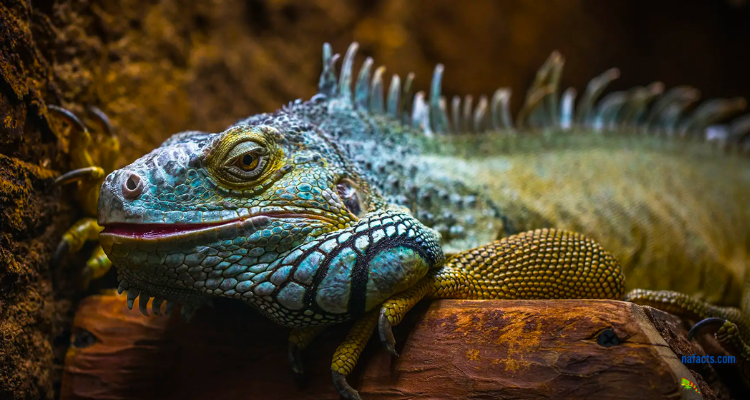Debunking the Myth: Are Iguana Dangerous?

Iguanas, with their prehistoric appearance and sometimes imposing size, have long sparked fascination and curiosity among people. These reptiles are known for their striking appearance, unique behaviors, and sometimes misunderstood temperament. However, amidst the awe they inspire, questions often arise about their potential danger to humans. In this comprehensive examination, we delve into the behaviors, biology, and interactions with humans to determine whether iguanas truly pose a threat and debunk the myths surrounding their perceived danger.
Understanding Iguanas:

Iguanas are members of the reptilian order Squamata and belong to the family Iguanidae. They are primarily found in Central and South America, as well as some Caribbean islands. With their elongated bodies, powerful tails, and prominent dewlaps (throat fans), iguanas are instantly recognizable. They come in various species, but the green iguana (Iguana iguana) is one of the most commonly encountered in the pet trade and in the wild.
Physical Characteristics: One of the first impressions people have of iguanas is their formidable size. While hatchlings may fit comfortably in the palm of one’s hand, adult iguanas can reach lengths of up to six feet or more, with the majority of that length being their long tail. This size, coupled with their muscular bodies, can give them an imposing presence.
Dietary Habits: Iguanas are primarily herbivores, with a diet consisting mainly of leaves, flowers, and fruits. In their natural habitat, they play a crucial role in seed dispersal and maintaining the balance of plant populations. However, captive iguanas often have dietary issues due to improper feeding, leading to health problems such as metabolic bone disease.
Behavioral Traits: Understanding iguana behavior is key to addressing concerns about their potential danger. While they may seem solitary, iguanas are social creatures within their own communities. They use various forms of communication, including visual displays, head bobbing, and vocalizations, to establish dominance, attract mates, and defend territory. Contrary to popular belief, their aggression is often a result of fear or stress rather than inherent malice.
Perceived Threats: Despite their largely herbivorous diet and relatively docile nature, iguanas are sometimes perceived as dangerous animals. This perception stems from several factors, including their size, intimidating appearance, and occasional defensive behaviors. Additionally, incidents involving iguanas defending themselves or reacting aggressively in unfamiliar situations have contributed to this misconception.

Dispelling Myths: To accurately assess the danger posed by iguanas, it’s essential to separate fact from fiction. One common misconception is that iguanas are venomous, which is entirely untrue. Iguanas lack venom glands, and their primary means of defense is through their powerful jaws and sharp teeth. While a bite from an iguana can be painful and cause injury, it is rarely life-threatening and is usually a last resort when the animal feels threatened or cornered.
Another myth is that iguanas are inherently aggressive animals. In reality, most iguanas prefer to avoid confrontation and will only display aggression when they feel threatened or provoked. By understanding their body language and respecting their space, conflicts can often be avoided altogether.
Interactions with Humans: In regions where iguanas coexist with human populations, interactions are inevitable. While some people may view iguanas as pests due to their habit of foraging in gardens and occasionally damaging vegetation, others appreciate their presence as a natural part of the ecosystem. Responsible management strategies, such as habitat preservation, education, and humane deterrents, can help mitigate conflicts and promote peaceful coexistence.
Pet Ownership: The popularity of iguanas as pets has led to a surge in captive breeding and ownership. While they can make fascinating and rewarding companions for experienced reptile enthusiasts, iguanas are not suitable pets for everyone. Their specialized dietary and environmental needs, along with their potential for aggression as they mature, require careful consideration and commitment from prospective owners. Sadly, many iguanas end up in shelters or rescues due to owners underestimating the challenges of proper care.
Bite Injuries vs. Actual Threat:

While iguanas have sharp teeth and powerful jaws capable of inflicting painful bites, instances of severe injury to humans are rare. Most bites occur when the animal feels threatened or cornered, and they typically prefer to flee rather than engage in confrontation. Proper handling techniques and understanding their body language can greatly reduce the risk of bites and injuries.
Territorial Behavior: Male iguanas, especially during the breeding season, may exhibit territorial aggression towards other males. This behavior is primarily directed at conspecifics (members of the same species) and is intended to establish dominance and secure mating opportunities. However, such aggression is typically confined to interactions within their own species and does not necessarily extend to humans.
Health Concerns: While not directly related to aggression, iguanas can carry certain pathogens that may pose risks to human health, such as Salmonella bacteria. Proper hygiene practices, such as thorough handwashing after handling or cleaning enclosures, can mitigate these risks effectively. Additionally, routine veterinary care and appropriate husbandry practices can help ensure the health and well-being of both captive and wild iguanas.
Conclusion:
In conclusion, while iguanas may possess certain physical attributes and behaviors that can be misconstrued as dangerous, they are not inherently aggressive or harmful animals. Like any wild creature, they deserve respect, understanding, and responsible management to ensure harmonious coexistence with humans. By dispelling myths, promoting education, and implementing proactive conservation measures, we can foster appreciation for these remarkable reptiles and minimize conflicts in shared habitats.




